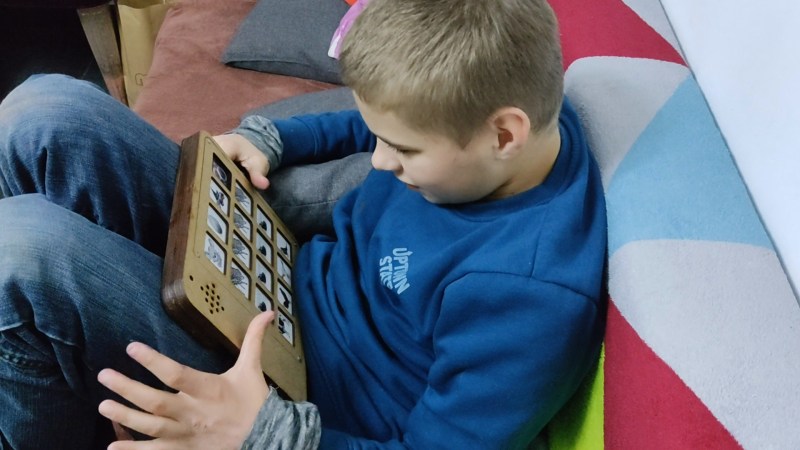One way of communicating with autistic and non-verbal people is through the use of a Picture Exchange Communication System or PECS board, which they can use to point out what they need or want throughout the day. However, the commercial versions of these boards have their share of problems — they’re expensive, and they’re fairly rigid as far as the pictures go. [Alain Mauer] has created an open-source PECS board that is far more personalized, and has audio to boot.
The number one requisite here is sturdiness, as [Alain]’s son [Scott] has already smashed two smartphones and a tablet. [Alain] went with a laser-cut MDF enclosure that should last quite a while. Inside is an Arduino Pro Mini and a DF Player Mini that plays corresponding clips from a micro SD card whenever [Scott] presses a button on the 16-key copper foil capacitive keypad. This PECS board is smart, too — it will sound a turn-me-off reminder after a few minutes of inactivity, and issue audible low battery warnings.
So far, [Scott] is responding better to photographs of objects than to drawings. Watch him interact with the board after the break.
This is far from the first thing [Alain] has built to help [Scott]. Be sure to check out this Pi-based media player built to engage and not enrage.

















Reminds me of when I was traveling abroad many moons ago, when cell phones were huge and my wallet was bare. I’m severely hearing impaired so picking up a foreign language was going to be next to impossible and had to do a study-abroad program. I bought a sketchbook to keep myself occupied on the plane over, realizing I could draw pictures of all the things I might need while I was there would be a good idea. Filled it with drawings of toilets, bars, foods, places… turned out to be a great way to navigate around the language barrier. Pointing at my ears and shaking my head ‘no’, then tapping the picture in my book… on the back they would draw a map, write down the name of streets, etc.
Between art school and necessity I became a world class Pictionary player!
Haven’t had the need again, but I imagine things like this may already exists for all sorts of people when it comes to traveling abroad.
We’ve got a small pocket sized book with very clear pictures of all the things you’re most likely to need to communicate when travelling, all organised thematically. Very useful when you need it, particularly when there’s a local dialect so people aren’t even that fluent in their ‘official’ language.
Haven’t travelled for some time now, so can’t remember what it’s called but I’d imagine Google can find something.
Great idea! I’ve seen a t-shirt that’s meant for travelers that sounds quite similar, but that wouldn’t be as easy to read/flip through/have with you every day.
That’s awesome. I’d imagine the grid may make it easier to use than a flat, featureless touchscreen? Also the flex in wood (vs glass screen strong but brittle) will probably protect it against damage.
This is basically an AAC device. Very commonly used with nonverbal folks woth special needs. I’ve made a few myself, and when you look at how wildly expensive they can be for how limited and simple they usually are it’s frustrating as hell. Toss an Adafruit sound board with some pictograms on buttons for basic necessities in life and you’ve likely made something that’s better than commercial units that sell for north of $400.
Maybe hacking a vtech toy like the Call and Chat Learning Phone